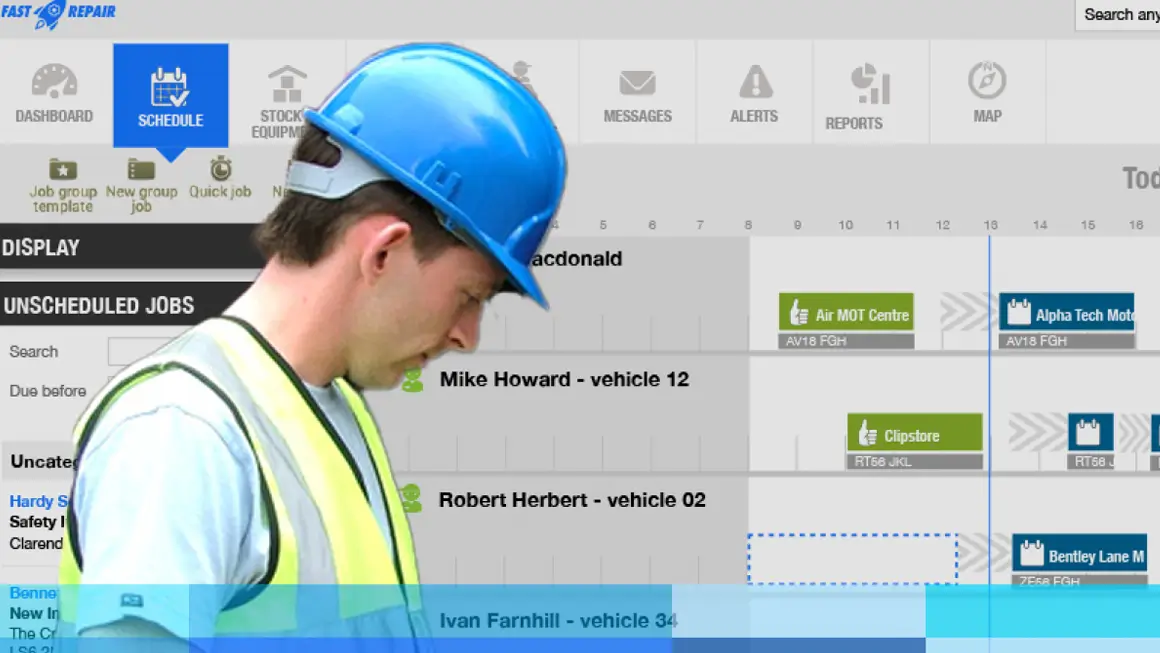IN THIS BLOG WE’LL TALK THROUGH HOW OTHER FIELD SERVICE BUSINESSES AVOID COMMON OPERATIONAL ISSUES.
When it comes to running a slick field service management operation, there are three key areas in which businesses trip up: process, communication, and not focusing on the customer.
These all have a direct impact on profits and so getting these things right should be on everyone’s 2023 wishlist.
Let’s dive straight into the 6 most common pitfalls… And, more importantly, how to dodge them going forward.
FIELD SERVICE MANAGEMENT MISTAKE #1: LOW FIRST-TIME FIX RATES
Measuring first-time fixes is likely one of your top KPIs because it’s used to measure quality and productivity.
Jobs that aren’t complete when an engineer first attends, or when they go back to rectify an issue, are a leading cause for haemorrhaging money for most field service businesses.
Why? Because low first-time fixes direct engineers away from new business opportunities, cost money, lower productivity, and overall they don’t create a great impression for the customer.
Here’s how to fix this 👇
💡Top tip: Field service businesses that nimbly avoid this issue focus on customer intel – they know the precise job details and make sure they have everything they need for the job. Using a CRM software will ensure that your office staff have access to all of the job information for a customer… Make it cloud-based and your field service workforce can access it too. Better yet, if you use a fully integrated field service management software, teams can update each other at all times, wherever they are.
📕Want to learn more? Read: Top 5 tips to improve cost efficiency in field service management
FIELD SERVICE MANAGEMENT MISTAKE #2: LACKING ROBUST PLANNING
To achieve first-instance and first-time fixes, you need to be prepared. And this covers everything from inventory and stock control through to scheduling engineers to be at jobs as quickly as possible.
Put simply, not having the right tools or parts means the job won’t get fixed the first time around. Seems obvious, but this is largely overlooked by the majority of field service businesses.
The cause? Often, it’s because of a lack of customer intel or reduced technical understanding of other team members planning in jobs.
Again, the inconvenience of an unfinished job could have serious complications for the customer (e.g. going without utilities)… And at best, would require the customer needing to become available again due to a missing part, which can damage your reputation.
💡Top tip: Savvy field service businesses now prepare jobs on an individual basis. They look at the exact stock needed, any specialist knowledge required, and even the location in relation to other jobs on the schedule to optimise field workers’ time and routes. This can all be managed through a job planning tool so that everyone is on the same page.
📕Want to learn more? Read: How does job management software actually save your field service business money?
FIELD SERVICE MANAGEMENT MISTAKE #3: DIFFICULTY MONITORING OPERATIONAL PERFORMANCE
Data is now deemed the most valuable asset in the world, according to The Economist. In fact, 76%1 of businesses say it’s an integral part of forming their business strategy.
To sum up, accurate data and analytics on everything from customer information through to field visit reports and job sheets allow you to not only get the information you need, when you need it… It also allows you to track everything down to fuel used, miles travelled, overtime used, and more.
💡Top tip: With the right business intelligence tools, you can track every element of a job in a single platform. The end result? You can streamline operations, improve job profitability, AND increase customer satisfaction.
📕Want to learn more? Read: 5 job management challenges and how to overcome them.
FIELD SERVICE MANAGEMENT MISTAKE #4: USING OLD-SCHOOL METHODS
The biggest cause of the first three top mistakes? Sticking to the way things have always been done.
Field service businesses that continue to lean on paper tickets, Excel spreadsheets, whiteboards and the likes, find it almost impossible to avoid wasting effort and days of time fixing things, making it hard to compete in an increasingly digital world.
Plus, these manual methods leave businesses open to human error, slow invoicing and cash flow, and customer dissatisfaction.
Here’s just one example: A&S Newbuild Aftercare saw a boost in turnover of £5m in just two years after switching to digital operations. Find out how, right here.
💡Top tip: Once a field service business says goodbye to old methods, every area of the business is easier to manage — from reducing manual processes through to real-time reporting. With a proper job management tool, being slow is no longer an issue that impacts competitive advantage.
📕Want to learn more? Read: Moving from manual to automated job management
FIELD SERVICE MANAGEMENT MISTAKE #5: POOR COMMUNICATION
There’s no doubt that poor communication across a field service business leads to bad coordination.
Keeping field service teams on the same track as back-office teams can be tricky, particularly if you’re using the old-school methods mentioned above that just don’t allow the two to easily update each other.
This has impacts on all areas of operations from job scheduling, planning in first-fixes or attending emergencies, all the way through to accounts as work cannot be invoiced until a report is filed saying the job is complete.
💡Top tip: This all changes with real-time updates on jobs, like live tracking of your field based teams. Automated texts and emails free your office staff from repeat process drudgery whilst actually improving your customer comms. Meanwhile, field workers can use a mobile device to access the job data they need and can then quickly file reports and get customer signatures on the job.
📕Want to learn more? Read: Going paperless: What does it really mean for field service management
FIELD SERVICE MANAGEMENT MISTAKE #6: PUTTING THE CUSTOMER EXPERIENCE LAST
So we’ve already touched on customer experience briefly in the sections above. It’s easy to see why a customer focus is beneficial.
Yet, in so many industries — not just field services — this one can often get dropped towards the bottom of the priority list.
With the pressures on other KPIs like first-time fixes and other cost efficiency strategies, the impact of strong customer service on profits falls behind.
But, ultimately, boosting customer experiences bolsters profits and business growth.
Here’s just one example: Comlink Fire and Security increased their turnover by 298% by digitising internal business processes to improve customer service. Read more here.
💡Top tip: With a CRM built specifically for field service businesses, you can improve all areas of the customer experience from booking in the initial appointment through to providing self-service tools for them to book in, pay invoices and provide feedback. All this is automated with the right tool, so it’s quick and frees you up to focus on other work.
📕Want to learn more? Read: How to use CRM to improve the customer experience
KEY TAKEAWAY
As you’ve probably guessed, tech and going digital with field service operations is how businesses are supporting growth in 2023 and beyond.
But before you go comparing software providers, we’ve one final takeaway for you.
⚠ Look out for an all-in-one job management software solution. And one built specifically for field service businesses. Reason being, if you choose different software solutions for each of these challenges, you’re leaving yourself open to gaps in service and profitability.
Why? Because the systems just don’t talk to each other or provide one single view of business operations. And teams continue to work in silo — which defeats the object.
If you’re ready to grow your business and profit margins, you’re probably ready for automated job scheduling. Why not jump straight in and book a one-on-one demo with our field service business specialists? We’ll show you exactly how our software can help you avoid these common mistakes to win you more work, reduce operations costs and satisfy customers.
Sources:
1 Reea Global









